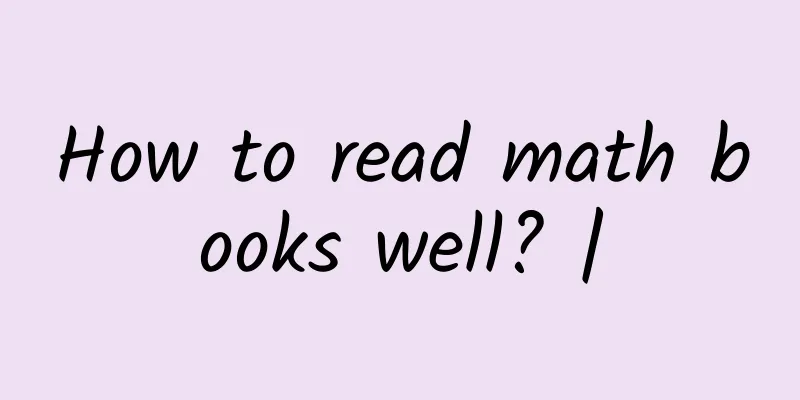How to read math books well? |

|
Professor Li Tianyan (1945-2020) is extremely well-known in China. He not only has his academic masterpiece "Period Three Means Chaos", which is called an immortal treasure by the famous physicist Dyson, but also proved a mathematical conjecture of Ulam, the "father of the hydrogen bomb", and a constructive proof of the famous fixed point theorem of Dutch mathematician Brouwer, which established his academic status in the two fields of chaotic dynamical systems and homotopy continuation algorithms. Such an academic giant is also a "Shi Tiesheng of the mathematics world" who has undergone about 20 major operations and countless minor operations. As a student of Li Tianyan, Professor Ding Jiu of the Department of Mathematics at the University of Southern Mississippi in the United States has deep feelings for his mentor. When Professor Li just passed away, he wrote in tears "Unforgettable 35 Years of Teacher-Student Relationship: Remembering the Legendary Chinese Mathematician Professor Li Tianyan". Later, he collected more information and completed a tearful work - "Out of Chaos: My Mathematical Relationship with Li Tianyan". For a detailed introduction, please refer to the book review at the end of the article. Here, I would like to excerpt the fifth chapter of the book "The Magic Method of Reading" for scholars to appreciate. This article is authorized to be excerpted from Chapter 5 "The Magic of Reading" in "Out of Chaos: My Mathematical Relationship with Li Tianyan" (Shanghai Science and Technology Education Press). The title is added by the editor. Go to the "Fanpu" public account and click "Read the original text" at the end of the article to purchase this book. Written by Ding Jiu (Professor of Mathematics at the University of Southern Mississippi) As is often done in mathematics, before discussing the "magic method of reading" in detail, we first make an assumption that the teacher of the subject and the selected textbooks are satisfactory; if it is self-study, it is also assumed that the motivation for learning is not a problem. In addition, the role of intelligence is not a factor we want to consider. Under these relatively ideal backgrounds, how can we read a mathematics book effectively? Professor Li Tianyan has summarized valuable reading tips after long-term book study and research practice in Taiwan and the United States. I have also accumulated some experience of "reading good books" in my reading career over the past few decades. After leaving his teacher for 30 years, my relationship with him as a teacher and student has not only not faded, but has continued to grow. One of the key factors is that we have almost the same views on many issues about life, learning, teaching, research, and speech, and we also follow the code of conduct that we both strongly agree with. The focus of this chapter on "how to learn mathematics" is certainly a summary of Professor Li Tianyan's lifelong reading and research, but it is also interspersed with my understanding of reading and learning. We teachers and students have deeply realized that the most important magic weapon to learn mathematics well is to master the concepts. In fact, this is also the common experience of some of my university classmates who have learned mathematics thoroughly. Since Professor York and I had a comprehensive exchange on education issues at the teacher-student gathering to celebrate Professor Li's 70th anniversary in July 2015, I will also relay some of York's insights on reading. Mathematics is based on axioms and postulates, guided by definitions, and uses logic as a means to gradually deduce useful propositions that reveal the various properties of concepts and their relationships with other concepts. In this process, the art of reasoning is crucial. And all our skills in understanding theorem proofs were initially trained from the Euclidean geometry we learned in middle school. Therefore, Wei Musheng, who scored full marks in mathematics in the 1977 Jiangsu Province College Entrance Examination and my college classmate, believed in a conversation with me at Michigan State University that plane geometry is the most important middle school mathematics course. In mathematics, the definition of a new concept must use other concepts, and the propositions belonging to it are nothing more than about the nature, use or relationship of the concept with other concepts. In the description of a proposition, all the concepts involved must have been clearly and clearly defined, otherwise even a genius cannot understand the proposition. Therefore, in their proofs, the mathematical concepts encountered are everywhere. Therefore, when encountering a certain concept, a complete image of it should emerge in your mind. For example, there is a simple proposition in the series theory of calculus: if the infinite series converges, the general sequence of the series must tend to 0. In this proposition, there are two basic noun concepts, namely "series" and "sequence", and an extremely important "convergence" concept, which are used for series and sequence respectively. Therefore, when proving this proposition, you must have a clear understanding of the definitions of these concepts and the relationship between them. If even the definition of convergence of a series remains vague, or if we have not yet figured out the relationship and distinction between the general sequence of a series and the parts and sequences of the series, how can we derive the necessary conditions for the convergence of a series that its general sequence tends to 0 from the convergence of a series? Although concepts are so important, too many students do not take them seriously, or simply do not know the "mastering concepts" as a powerful tool for studying. One reason may be that they were misled by the baton of the college entrance examination and the tactics of the sea of questions in primary and secondary school before entering college, and only wanted to memorize by rote. They passively accept this worst way of studying, or perhaps another reason is that for them, reciting definitions is easier and more relaxed than understanding them. Reciting definitions is just a mechanical behavior, just like the old private school teachers in the old days shaking their heads and teaching students to recite ancient books. Understanding concepts requires brain thinking. The concept definitions in well-written mathematics textbooks are expressed very clearly, and the words and sentences are also very economical, that is, there are no redundant words in the sentences, and every word has meaning. To fully understand the connotation of complex definitions containing many logical conjunctions, it is not possible to master them just by memorizing them. It requires continuous thinking and contemplation when reading the definition, and to rack your brains to understand it thoroughly. A good way to test whether you really understand a definition is to ask yourself what you should say when the definition is not valid. If you can't write it down, you are probably still a long way from truly understanding the definition. When Professor Li Tianyan is teaching in class and explaining an abstract concept, he likes to illustrate it with examples. The first time I heard his lecture in Guangzhou, I was fascinated by his method of “simplifying the complex.” I also recorded his demeanor when he substituted for Professor Yan in the first semester in the United States. That was my first time listening to his class in the United States. Now let’s take an example and try to negate a mathematical statement. Let’s start with calculus, which every science and engineering student has learned. It is assumed that the reader has learned the rigorous “ε-δ” language limit definition. Let’s recall this definition first: Let f be a real-valued function of a real variable x, and given a real number a in the domain interval of the function. If there exists a real number L such that for any positive number ε, there exists a positive number δ such that when x is in the interval, it satisfies the inequality 0. Memorizing without thinking is a big mistake that many people make when learning mathematics today, and it has been criticized by Professor Li Tianyan. During the years when I was studying at Michigan State University, I heard him talk about a true story that happened in the Department of Mathematics at the University of Maryland, his doctoral alma mater. A foreign student was going to take an oral examination for a doctoral qualification examination. The examiner asked the interviewee to prove the famous Tikhonov theorem in point set topology, but only asked her to prove a simplified version in two dimensions: the product of two compact sets is also a compact set under product topology. However, the doctoral student begged the professor to let her prove the general Tikhonov theorem: the product of any compact sets is also a compact set under product topology. The reason is that she has memorized the proof of this general conclusion from beginning to end, but she can't prove the special case of the theorem. In fact, this phenomenon is quite common. Some students have memorized the above-mentioned limit definition by heart, but still do not understand the meaning behind this definition. Once they use it in a specific situation or do a slightly challenging limit problem, they fall into the fog and don't know where to start. In some situations where it is necessary to prove that the limit does not exist, or even if the limit exists, its value is not a given number, it is even more at a loss. When reading a math book with content that is not easy to digest, it is often difficult to understand complex definitions or difficult theorems. If this happens, don't be too pessimistic and disappointed. At this time, you need sufficient patience and confidence. Looking back at past concepts is often the right choice. Here we might as well borrow the reading guidance advice that Richard Feynman (1918-1988), an outstanding American physicist, gave to his sister, who was nine years younger than him, when he was 23 years old: "You start from the beginning, and read as much as you can until you are completely confused, then start from the beginning again. Keep reading until you can understand everything." This method is effective and is most suitable for self-taught people who want to learn without a teacher. Feynman's sister used this method to finish and understand a book on astronomy. The joy of success prompted her to choose this subject as her lifelong career. I have been self-studying for a long time, and I often use this back-and-forth method to overcome every chapter and section in a mathematics book. Professor Li has been studying the solution of polynomial equations for a long time, and he has self-taught non-commutative algebra, which is a close brother of algebraic geometry. I believe that he is also consistent with Feynman's approach. Those of my college classmates who had a solid foundation in analytical mathematics must have thought the same as Feynman: when they encountered something they didn't understand while reading, they would start over again from the beginning, making steady progress step by step, and eventually master the entire chapter or section. Understanding proofs and being able to learn how to do them is a key step in reading math books. Professor Li Tianyan's most averse approach to learning math is to recite proofs without understanding them. So when his students want to report the proof of a theorem to him, he will never ask you to prove the general conclusion, but ask you to prove a specific simple case to see if you really understand it. He not only requires this of his students, but also demonstrates it in person. When he was approaching retirement, he was invited to explain his proof of "the existence of three points of a continuous function period implies the existence of n points of a period" to several visiting students from China. One of the students, Xu Shitan, is now a formally admitted doctoral student in the department. In a photo he sent me of Professor Li demonstrating the proof, I saw that the blackboard was written to prove the special case when n = 4, and the idea of proving that the conclusion is correct for general positive integers n is fully demonstrated in this specific proof. So to become Professor Li's student, you must be able to prove the special conclusion when n = 3 or 4. Professor Li teaches students about chaos theory in 2017 The problem is that in textbooks or monographs, the authors do not write down the proof of the specific theorem when n = 3 or 4, and the description of the theorem and its proof are basically general. How can we understand the complex and lengthy proof? Let's read Professor York's advice: "Students (and even professors) should try to understand the key ideas in the proof, and preferably find two key ideas. These key ideas do not necessarily have to appear in the form of 'lemmas', because the book may point out too many seemingly plausible key clues. In fact, the key idea is often the one that surprises students, so different people will pick out different key ideas in a proof. They are the key elements to improve our understanding. A key idea may have a complicated proof, so students should discover two key ideas in the process." In a long email to me in July 2015, Professor York gave two examples to illustrate how to find the key ideas in the proof. Probably because the "intermediate value theorem" about continuous functions in calculus played a key role in his and his students' most famous articles, he used the proof of this theorem as the first example. The geometric meaning of the theorem is also understandable to most people: any continuous curve connecting a given point on each side of a straight line must pass through the line at least once. Its strict mathematical statement is: if f is a continuous function with real values defined on a closed interval [a, b], then for any number d between the function values f(a) and f(b), there exists a point c in [a, b] such that f(c)=d. The first key idea in proving the theorem is to divide the interval [a, b] into two closed subintervals through the midpoint of the interval, each with half the length of the original interval, then the number d must be between the two function values of f at the two endpoints of one of the two closed subintervals, and the subinterval determined by this property will replace the original interval. The second key idea is that as long as d does not become the function value of f at one of the endpoints of the subinterval currently obtained, the idea of bisecting the interval above is repeated, and the property that the number d is always between the function values at the two end points of the interval is maintained. If the required function value d cannot be obtained at each step of the above process, an infinite sequence of closed intervals can be obtained, each time the length is reduced by half and the front is nested in the back. The lengths of these intervals will eventually tend to 0, so the "closed interval nesting theorem" about real numbers ensures that they have only one common point c. According to the assumption that f is a continuous function, the point c must satisfy the equation f(c)=d. The above two ideas are the key ideas needed to prove the intermediate value theorem. Perhaps because of the telling “qualifying oral exam” in the history of the Department of Mathematics at the University of Maryland, where he was the dean, the second example Professor York cited was the standard proof of the Tikhonov theorem mentioned above. This proof is naturally much more difficult, and it also requires the set theory axiom of choice of Ernst Zermelo (1871-1953), which is not recognized by every mathematician, so I will not explain it in detail here, but just point out that there are two key ideas that lead to the proof. Readers who have a foundation in topology and want to trace the source of the proof can read the details in the appendix "Professor York on Education" of my book "Personal Experience of American Education: Thirty Years of Experience and Thinking" published by the Commercial Press in 2016. York is qualified to teach the secret of good mathematics, because he is a world-renowned chaos master, and for this he shared the 2003 Japan Prize with Benoit B. Mandelbrot (1924-2010), the "father of fractals". In the eyes of his disciples, his chaotic dynamical system research team at the University of Maryland should have the best academic reputation in the United States. However, such a creative research mathematician only scored 87 points in all math courses in high school, and none of them were "excellent". This is not "fake news" heard from others. I can see it clearly from all the high school transcripts he emailed to me. But I have heard that many primary and secondary school students in China have an average math score of around 95 points, and they still have to go to "tutoring classes" outside of school to continue processing because they have not reached the height of "perfect scores". However, York told me, "I learned how to learn math when I was in high school." So he won the third place in the high school math competition in his hometown of New Jersey. After York was admitted to Columbia University for undergraduate studies, his transcripts were still "unremarkable". He kept his students in suspense by saying, "I didn't get any Bs in college." Li Tianyan initially thought, "All As," but the answer he got was, "C or below." However, Professor Li Tianyan, who had a very good math transcript in college, wrote in his article "Looking Back on the Road I've Traveled": "Although my records at that time were extremely outstanding, now I think back I actually knew nothing at the time and had no idea what I was doing. When I was in school, I could only memorize theorems and logic to cope with exams. After graduation and military service, I had forgotten most of what I had learned. To be honest, before going abroad, I really wanted to give up mathematics. Later, I met my mentor, Professor York, in the United States. From him, I gradually gained some preliminary understanding of learning and researching mathematics, and these understandings greatly contributed to my vision and approach to studying mathematics in the future." What a heartfelt statement! At least when it comes to studying mathematics, grades are not important, because learning mathematics is not about training memory, but about training the ability to understand the world. The cultural differences between the East and the West also affect the habits of reading and learning. In the East, especially in China today, people learn mathematics by passively following the logical reasoning process in textbooks, just for the sake of memory and not for thinking. They only know why this step leads to the next step, and the next step leads to the next step, and finally the conclusion of the theorem. They seem to understand the process of proof, but they don’t really understand it, and can only cope with exams. Good Western students often ask "why" when studying: Why is it like this? Why do you do this? These questions are rarely encountered in exams, but they often appear when doing research. So York joked to young students: "If you just want to pass the exam, just memorize the proof of the theorem. But if you want to do research, you must really understand the two key ideas in the proof." Doing exercises is an indispensable part of learning mathematics, but doing them scientifically not only saves time, but also can achieve twice the result with half the effort. When I was in college, it became a trend for mathematics students across the country to do the "Mathematical Analysis Exercises" by Belarusian mathematician Boris Pavlovich Demidovich (1906-1977). This book has made an indelible contribution to the cultivation of people's reasoning ability. It can even be said that it is no less than the multi-volume extracurricular reference book and the famous book "Calculus Course" by Soviet mathematician Gregory Mikhailovich Fichtenholz (1888-1959), which was almost a set of extracurricular reference books for mathematics students at that time. My classmate Tian Gang did about 20,000 exercises during his undergraduate studies, which laid the foundation for his outstanding mathematical life later. But when he was interviewed by reporters, he did not approve of the current college students doing so many questions and being trained to be a "question-solving machine", just like the exaggerated image of "rolled into a machine" left by the comedy master Charles Chaplin (1889-1977) in the classic film "Modern Times". Due to the pressure of the college entrance examination and the desire to be admitted to a prestigious university, Chinese high school students actively or passively do countless questions in the years before the age of 18. However, when they reach the university stage, many people's enthusiasm for doing exercises is like a deflated ball. Both extremes are not smart. Under normal circumstances, how can we "do questions scientifically"? The purpose of exercises is to consolidate the understanding of concepts and strengthen the ability to apply concepts. Therefore, if you have not yet understood the connotation of the concept before doing the questions, do not do the questions in a task-like manner. In addition to a small number of "conventional questions" used to review concepts or directly apply propositions, good textbooks list exercises, and there are also a number of challenging and exquisite questions that are icing on the cake. Some well-written textbooks even put some results with improvement in the exercises to challenge readers to see who dares to take up the challenge. You should dare to try such questions, and don't do too many "routine questions" that require almost no thinking. This is a good way to improve your math level and future innovation ability. One thing that is inseparable from the student years is "scores". Naturally, everyone likes good scores as much as they like beauty. Test scores are of course important, because they are the only way for the school to evaluate how well students have learned the course, and they can basically reflect the degree of knowledge mastery. A good transcript, as a record of reading history, can make you happy for the rest of your life. I got a record-breaking high score in the National Foreign Language German Test that year. When I got the transcript from the secretary of the Dean of Graduate Affairs, I was a little proud when I walked out of the office. Although I was mocked by my supervisor's reply letter for my hasty announcement of the good news, I still firmly believed that "it is better to get a high score than a low score." This is of course true, but the fact is that in the past 33 years, I have never had the opportunity to read a mathematical article in German or Russian. There was one time when I particularly wanted to read the description and proof of a classic ergodic theorem published in 1950, but the article was written in French, which I couldn't understand. In mainland China, if a high school graduate's college entrance examination score is one point less, he or she may miss out on the long-cherished double first-class university. Therefore, many parents who want their children to succeed admire the high score makers like Hengshui Middle School who win through extreme methods and devilish training. Under the current college entrance examination system, this score is indeed extremely important. However, as Mr. Ting Zhaozhong (1936-), the Nobel Prize winner in physics, said, he did not find any Nobel Prize winner (naturally including himself) who was the top student in the class, but he did hear of someone who was the last in the class. This sentence is very telling: the purpose of studying is not to pursue the first place in grades, but to pursue the truth, understand the truth, and finally be able to create inventions and discover the truth after entering the workplace. If a student who studies pays too much attention to test scores and lacks foresight, and only focuses on the textbooks based on the test all day long without diligently reading extracurricular books to broaden his or her horizons, even if the test scores are among the best in the class, in the long run, there may still be regrets. A student with lofty ambitions should think about reading widely and laying a solid foundation for his brilliant future ten or twenty years later. Although Professor Li Tianyan had excellent grades in college, he never took this record seriously. In those years, he often reminded his doctoral students to learn "special skills" and to have "real talents and knowledge". Looking back on my time studying at Nanyang University, I am glad that I did not study for the sake of getting dazzling test scores, but hoped to absorb as much useful knowledge as possible like a sponge. It has become my habit to read a lot of extracurricular books, including mathematics and humanities. Usually, I don't have much time to read textbooks. But before each class, I will roughly browse the content that the teacher is going to talk about. After class, I just listen carefully without taking notes. At most, I will write down the content that I suddenly heard beyond the book in the blank space of the textbook. After listening attentively in class, I feel that the concepts have melted into my mind. But after I went to the United States, I found that many American professors did not teach according to textbooks, or simply did not use textbooks. They only listed a few reference books and relied on their eloquent tongues to sell knowledge. So I "turned over a new leaf" and started taking class notes. However, I prefer professors who do not teach step by step but encourage students to keep thinking. If we replay Professor Li Tianyan's three major mathematical contributions, we will find that he was involved in several different mathematical fields when he was a doctoral student, which is amazing. I only knew one of his works in China, but after coming to the United States, I was deeply influenced by him. I was not limited to mastering one craft, but tried to "know" his research results. This probably left a good impression on him, so much so that when my employer university helped me apply for a green card after I started working, I saw the recommendation letter he wrote to me from the human resources department, saying that among all his students, "he is the only one who understands all my research fields." Learning how to read provides a solid foundation for those who hope to engage in research and exploration in the future to take the first step in academic research. book review When love is deep, it is natural. When love is deep, how can we bear to give it up? ——Recommend "Out of Chaos: My Mathematical Relationship with Li Tianyan" Written by Wang Tao (Institute of the History of Natural Sciences, Chinese Academy of Sciences) Professor Li Tianyan (1945-2020) is extremely well-known in China, and even ordinary readers know his name. His paper "Period Three Means Chaos" is so famous that F. Dyson of the Institute for Advanced Study at Princeton called it an immortal treasure in mathematical literature in his famous speech "Birds and Frogs". It is enough to make such an achievement, and Li Tianyan also has two other masterpieces - the proof of a mathematical conjecture of S. Ulam, the "father of the hydrogen bomb", and the constructive proof of the famous fixed point theorem of L. Brouwer, a Dutch mathematician, which established his academic status in the two fields of chaotic dynamical systems and homotopy continuation algorithms. As a student of Li Tianyan, Professor Ding Jiu of the Department of Mathematics at the University of Southern Mississippi in the United States has deep feelings for his mentor and has repeatedly introduced Li Tianyan's mathematical achievements, academic ideas and tenacious will to domestic readers. After Li Tianyan's death, Ding Jiu was so sad that he could hardly control himself. He read through his long-collected diaries and the correspondence records of the two over the past 35 years, recalled every bit of the past, and wrote furiously under the advice of friends and the expectations of readers. It took him two and a half months to complete this tearful work - "Out of Chaos: My Mathematical Relationship with Li Tianyan" (hereinafter referred to as "Out of Chaos"). "Out of Chaos" uses the timeless scientific concept "chaos" as its title, which is also Li Tianyan's main label. How did Li Tianyan discover chaos? What are the wonderful stories behind it? Ding Jiu, who was born as a mathematician, has both the vision of a scientific historian and the writing style of a scientific writer. He often starts from the clues of history and uses beautiful words to explain Li Tianyan's mathematical contributions and related mathematical theories in a simple and clear way, so that readers can "out of chaos". It can be said that this book is a half-life biography of Li Tianyan. What moved readers most may be Li Tianyan's strong will. He fought against the disease for most of his life, but never gave up hope. Academician Yan Jia'an of the Chinese Academy of Sciences praised him in a poem, saying "It is comparable to the literary world's Shi Tiesheng". Professor Chen Guanrong of the City University of Hong Kong also invented an idiom for this reason - "Tianyan Tiesheng". However, biography is not the only theme of this book. As the subtitle suggests, the mathematical relationship between the author and his mentor is the core of this book. This book provides readers with a rare case study of the relationship between a mathematician and a student. After reading the whole book, readers will find that the "relationship" between the author and Li Tianyan can be described as "the relationship between father and son" and "the relationship between lovers". The first half of the book mainly tells how the author became Li Tianyan's student. The two protagonists are from Nanjing University in China and Michigan State University in the United States. In the 1980s, if the author wanted to become Li Tianyan's student, he really needed some fate, so that "the fate of thousands of miles can meet". Fortunately, the homology curve acted as a magpie bridge, and the author and Li Tianyan were able to meet for the first time in Yangcheng, China. Like a boy and a girl in love, in the process of becoming Li Tianyan's student, the author often felt happy, and occasionally stressed. After passing a number of tests such as TOEFL, English test, and doctoral qualification examination, the author finally became Li Tianyan's official disciple in January 1987. In the process of reading, readers can feel the author's sincerity. He never avoided the setbacks and failures he encountered, so this book is also a valuable memoir. Chinese people believe that "once you are a teacher, you are a father for life". As the author admits in the book, apart from his parents, Li Tianyan had the greatest influence on him. Especially during his study and work in the United States, Li Tianyan was like a kind but strict parent, teaching him the art of reading and the way of studying. In the process, the author also talked about his thoughts and experiences on education and culture in China and the United States over the years. These contents constitute the second half of the book. Li Tianyan was very concerned about these "children". He would be anxious about their occasional slackness, but also feel gratified by their continuous growth. He would also teach them how to make speeches, especially interview reports, so that they can find a satisfactory job after graduation and become popular teachers. What impressed the author deeply was Li Tianyan's feelings for his homeland. He had deep feelings for his motherland and taught the "children" to be neither humble nor arrogant and not servile to foreigners. After reading this book, I believe readers will be attracted by Li Tianyan's personality charm and moved by the author's true feelings of missing his teacher. During the reading process, if readers can refer to the author's other two books, "The Confusion of the Wise - Talking about Chaos Fractals" and "Personal Experience of American Education: Thirty Years of Experience and Thinking", they can not only deepen their understanding of Li Tianyan and his mathematical achievements, but also learn more about the true meaning of education in China and the United States. Li Tianyan can be comforted by the fact that his student Ding Jiu has written such a wonderful book on mathematics culture, which has enabled the vast number of Chinese readers to understand Li Tianyan's wonderful life and made his name deeply rooted in people's hearts. We hope that one day in the future the author can write a more complete "Biography of Li Tianyan", which will be a greater gift to readers. |
<<: Light Snow丨Don’t blame the rainbow for not having a shadow, now it’s light snow
>>: Winter health guide for diabetics
Recommend
Apple launches App Store gift cards. Can it learn from Tencent to open up China’s paid market?
In China, gift cards from various merchants are v...
Are you anxious about the college entrance examination? Let's hear what the experts say
It's June again, and as the college entrance ...
WeChat’s paid reading service has not yet arrived, but Douban Time has quietly gone online!
The paid era of the knowledge economy is still ad...
5 suggestions for new media operations!
Again, the same words: The method is the method, ...
A deer with plum blossoms on its face may not necessarily be a sika deer
When we talk about "biological invasion"...
[Dry Goods] Common data analysis table headers and assessment indicators for operations positions (I)
Internet operations are inseparable from various ...
"Chen Xiang's 6:30 Movie" 4 movies (2017-2020) HD Chinese subtitles
Li Dacong, the CEO of a technology startup compan...
High repurchase fan community operation strategy
Among the three major categories of communities, ...
Shenzhou 14 astronauts' first spacewalk! What's different about this spacewalk?
September 1st 19:09 Astronauts Chen Dong and Liu ...
Cold waves come one after another. Why are they still so severe amid global warming?
On November 30, the Central Meteorological Observ...
Analysis of channel operation: 3 major elements + 1 major core point
In the Internet environment, it is said that traf...
Android Annotations Quick Start and Practical Analysis
First of all, what is an annotation? @Override is...
Stellantis Group invests 11.6 billion to become a shareholder of Leapmotor and will establish a joint venture
NetEase Auto reported on October 26 that on Octob...
Two common bad habits are causing young people’s stomachs to collapse!
From Zibo barbecue to Tianshui spicy hot pot, eve...
Nature's compass
In ancient times, the compass was the most import...
![[Creative Cultivation Program] Snails run slowly, but they are not slow at all in “damaging” crops!](/upload/images/67f261d253209.webp)








